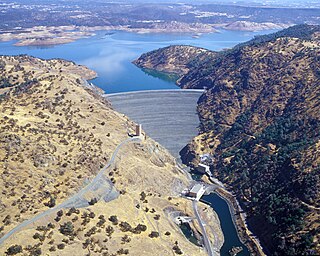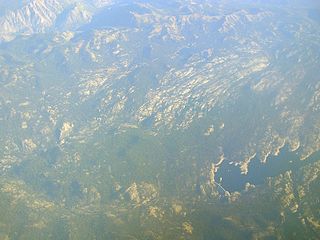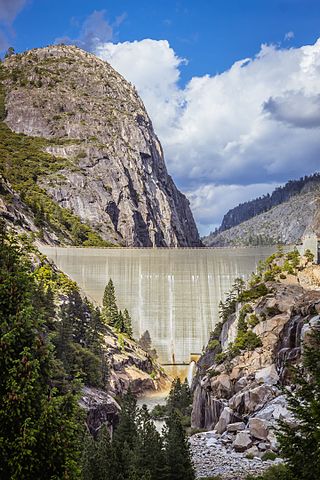Related Research Articles

Calaveras County, officially the County of Calaveras, is a county in both the Gold Country and High Sierra regions of the U.S. state of California. As of the 2020 census, the population was 45,292. The county seat is San Andreas. Angels Camp is the county's only incorporated city. Calaveras is Spanish for "skulls"; the county was reportedly named for the remains of Native Americans discovered by the Spanish explorer Captain Gabriel Moraga.

The Gold Country is a historic region in the northern portion of the U.S. state of California, that is primarily on the western slope of the Sierra Nevada. It is famed for the mineral deposits and gold mines that attracted waves of immigrants, known as the 49ers, during the 1849 California Gold Rush.

The Tuolumne River flows for 149 miles (240 km) through Central California, from the high Sierra Nevada to join the San Joaquin River in the Central Valley. Originating at over 8,000 feet (2,400 m) above sea level in Yosemite National Park, the Tuolumne drains a rugged watershed of 1,958 square miles (5,070 km2), carving a series of canyons through the western slope of the Sierra. While the upper Tuolumne is a fast-flowing mountain stream, the lower river crosses a broad, fertile and extensively cultivated alluvial plain. Like most other central California rivers, the Tuolumne is dammed multiple times for irrigation and the generation of hydroelectricity.

State Route 49 is a north–south state highway in the U.S. state of California that passes through many historic mining communities of the 1849 California gold rush and it is known as the Golden Chain Highway. The road was initially lobbied in 1919 by the Mother Lode Highway Association, a group of locals and historians. The highway begins at State Route 41 in Oakhurst, Madera County, in the Sierra Nevada. It continues in a generally northwest direction, weaving through the communities of Goldside and Ahwahnee, before crossing into Mariposa County. State Route 49 then continues northward through the counties of Tuolumne, Calaveras, Amador, El Dorado, Placer, Nevada, Yuba, Sierra, and Plumas, where it reaches its northern terminus at State Route 70, in Vinton.

New Melones Dam is an earth and rock filled embankment dam on the Stanislaus River, about 5 miles (8.0 km) west of Jamestown, California, United States, on the border of Calaveras County and Tuolumne County. The water impounded by the 625-foot-tall (191 m) dam forms New Melones Lake, California's fourth-largest reservoir, in the foothills of the Sierra Nevada east of the San Joaquin Valley. The dam serves mainly for irrigation water supply, and also provides hydropower generation, flood control, and recreation benefits.

The Stanislaus River is a tributary of the San Joaquin River in north-central California in the United States. The main stem of the river is 96 miles (154 km) long, and measured to its furthest headwaters it is about 150 miles (240 km) long. Originating as three forks in the high Sierra Nevada, the river flows generally southwest through the agricultural San Joaquin Valley to join the San Joaquin south of Manteca, draining parts of five California counties. The Stanislaus is known for its swift rapids and scenic canyons in the upper reaches, and is heavily used for irrigation, hydroelectricity and domestic water supply.
Archie Stevenot was a prominent citizen in Calaveras County, California and Supreme Noble Grand Humbug of E Clampus Vitus. Born in Carson Hill, Stevenot helped found the California Chamber of Commerce and his family established the borax industry in the state. He also established the Mother Lode Highway Association in 1919 which was primarily responsible for the creation of State Route 49. As a result, the bridge across the Stanislaus River between Tuolumne and Calaveras counties on SR 49 is named the Archie Stevenot Bridge in his honor, and his birthplace has been declared California Historical Landmark No. 769.
Melones is a former settlement in Calaveras County, California, now submerged beneath a reservoir named New Melones Lake. It lay at an elevation of 955 feet. Melones was founded on the site of a ferry operated from 1848 by John W. Robinson and Stephen Mead. The town initially took its name from the ferry.

Knights Ferry is an unincorporated historic community and census-designated place (CDP) in Stanislaus County, California, United States. Nestled in the foothills of the Sierra Nevada, it is about 30 miles (48 km) east of Modesto on the Stanislaus River. The Williams Ranch near the town was one of many filming locations for the television series Bonanza and Little House on the Prairie.

Area codes 209 and 350 are telephone area codes in the North American Numbering Plan (NANP) for the U.S. state of California. Their service area includes Stockton, Modesto, Turlock, Merced, Winton, Atwater, Livingston, Manteca, Ripon, Tracy, Lodi, Galt, Sonora, Los Banos, San Andreas, Mariposa, and Yosemite, the northern San Joaquin Valley, and the Sierra Foothills.

New Spicer Meadow Reservoir is a reservoir in the Sierra Nevada, within the Stanislaus National Forest in eastern Tuolumne County, California.

New Melones Lake is a reservoir on the Stanislaus River in the central Sierra Nevada foothills, within Calaveras County and Tuolumne County, California.

KRVR is a commercial FM radio station licensed to Copperopolis, California, and serving the Modesto and Stockton radio markets. Its studios and offices are on North Emerald Avenue in Modesto. The transmitter is on Route 4 between Copperopolis and Telegraph City, on a ridge 1600 feet above the Central Valley.
Table Mountain is a narrow, 18 mi (29 km)-long, sinuous, flat-topped ridge separated by erosional saddles into a series of mesas that extend from Lake Tulloch to just west of Columbia, California in Tuolumne County, California. It is just over 1,100 ft (340 m) in elevation at its southern end and just over 2,000 ft (610 m) in elevation at its northern end. Its flat top is part of a stack of multiple 80 mi (130 km)-long lava flows that have been eroded to form a series of mesas that extend from Knights Ferry to Sonora, California. Its crest varies in width from a narrow ridge to over 1,100 ft (340 m) wide. It parallels the adjacent Stanislaus River.
There are 21 routes assigned to the "E" zone of the California Route Marker Program, which designates county routes in California. The "E" zone includes county highways in Alpine, Amador, Butte, Calaveras, El Dorado, Placer, Plumas, Sacramento, Solano, Tuolumne, Yolo, and Yuba counties.

Beardsley Dam is a dam on the Middle Fork Stanislaus River in Tuolumne County, California. The site is surrounded by the Stanislaus National Forest.

Donnells Dam is a concrete arch dam located on the Middle Fork of the Stanislaus River in Tuolumne County, California. The water impounded by the 291-foot (89 m) high dam forms Donnell Lake in Stanislaus National Forest. The dam and reservoir are co-owned by the Oakdale Irrigation District and South San Joaquin Irrigation District, and the dam is one of three in the Tri-Dam Project. The other two dams in the project are Beardsley Dam and Tulloch Dam.
Lake Tulloch, located in Copperopolis, California, United States, is one of the few lakes in the state that has private shoreline houses. At roughly 504 feet (154 m) in elevation the lake covers 1,260 acres (510 ha). Lake Tulloch provides water needs to downstream users and hydroelectricity to users throughout the state.
Black Creek is a tributary of the Stanislaus River in Calaveras County, California, flowing about 13 miles (21 km) in a southerly direction through the Sierra Nevada foothills. Originating near Carmen Peak, it joins the Stanislaus River in Tulloch Lake, near Copperopolis.

Parrott's Ferry is a historical cable ferry site in Columbia, California in Tuolumne County, California. It is California Historical Landmark No. 438, listed on June 2, 1949.
References
- ↑ "O'Byrnes and Central Ferry - CalaverasHistory.org". Archived from the original on 2017-03-13. Retrieved 2017-03-12.
- ↑ "The many crossings of O'Byrnes Ferry".
- ↑ "O'Byrne's Ferry Bridge (No. 281 California Historical Landmark) | Sierra Nevada Geotourism".
- ↑ Coke Wood. "Old Corner:O'Byrne's Ferry Covered Bridge at Poker Flat". Old Timers Museum in Murphys, CA. Archived from the original on 2007-07-04. Retrieved 2009-02-02.
- ↑ "Historical Overview of the Lake Tulloch Area - CalaverasHistory.org". Archived from the original on 2017-03-13. Retrieved 2017-03-12.